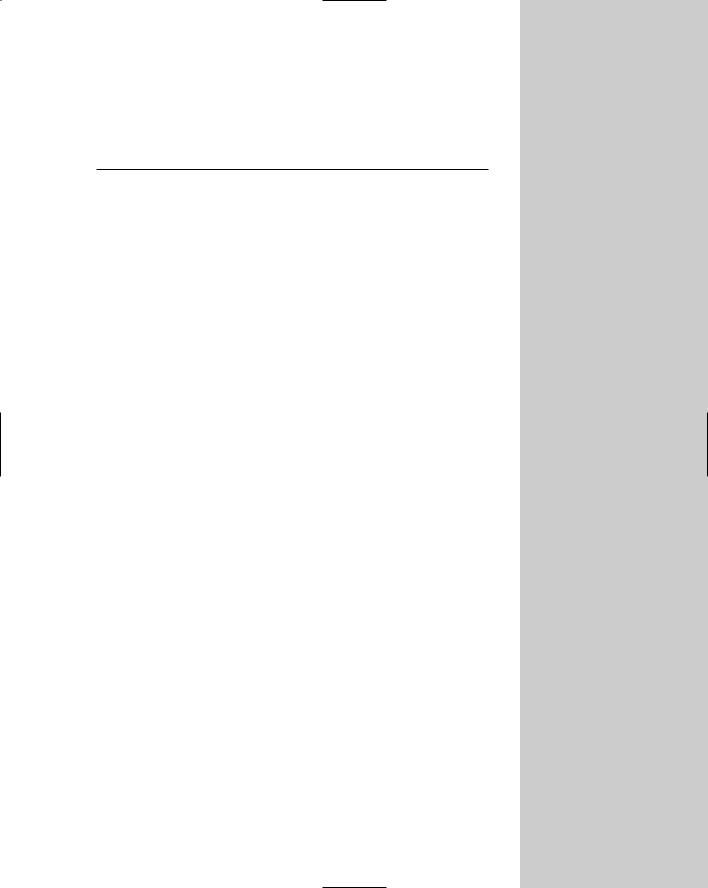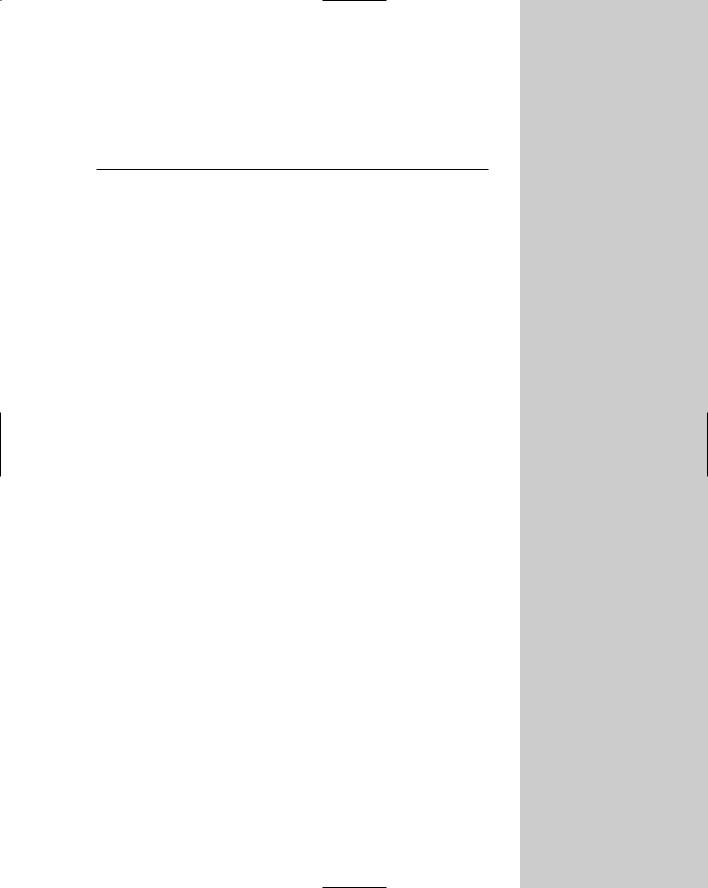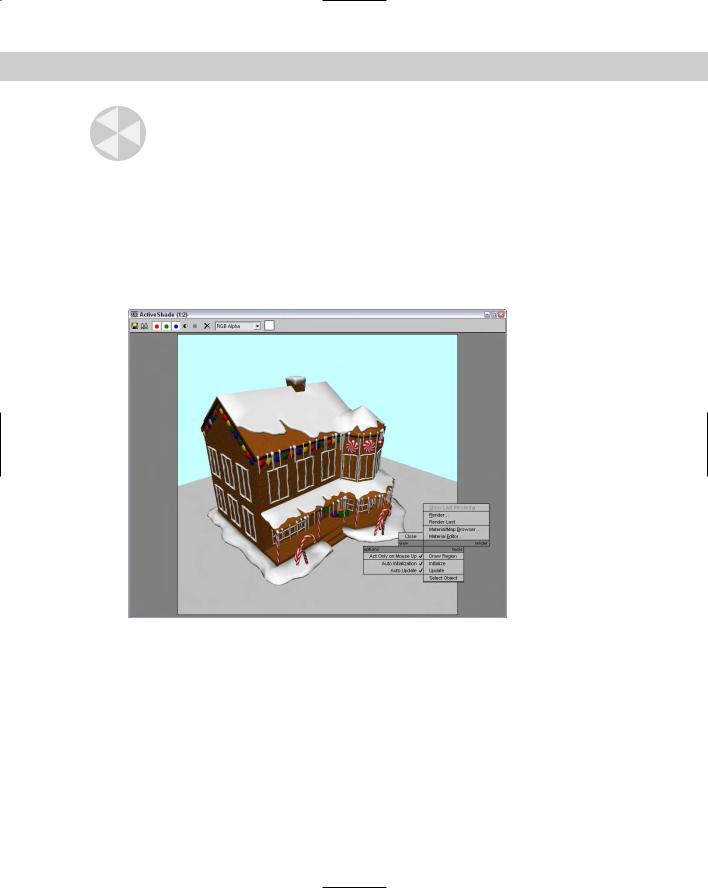
- •Preface
- •About This Book
- •Acknowledgments
- •Contents at a Glance
- •Contents
- •Relaxing at the Beach
- •Dressing the Scene
- •Animating Motion
- •Rendering the Final Animation
- •Summary
- •The Interface Elements
- •Using the Menus
- •Using the Toolbars
- •Using the Viewports
- •Using the Command Panel
- •Using the Lower Interface Bar Controls
- •Interacting with the Interface
- •Getting Help
- •Summary
- •Understanding 3D Space
- •Using the Viewport Navigation Controls
- •Configuring the Viewports
- •Working with Viewport Backgrounds
- •Summary
- •Working with Max Scene Files
- •Setting File Preferences
- •Importing and Exporting
- •Referencing External Objects
- •Using the File Utilities
- •Accessing File Information
- •Summary
- •Customizing Modify and Utility Panel Buttons
- •Working with Custom Interfaces
- •Configuring Paths
- •Selecting System Units
- •Setting Preferences
- •Summary
- •Creating Primitive Objects
- •Exploring the Primitive Object Types
- •Summary
- •Selecting Objects
- •Setting Object Properties
- •Hiding and Freezing Objects
- •Using Layers
- •Summary
- •Cloning Objects
- •Understanding Cloning Options
- •Mirroring Objects
- •Cloning over Time
- •Spacing Cloned Objects
- •Creating Arrays of Objects
- •Summary
- •Working with Groups
- •Building Assemblies
- •Building Links between Objects
- •Displaying Links and Hierarchies
- •Working with Linked Objects
- •Summary
- •Using the Schematic View Window
- •Working with Hierarchies
- •Setting Schematic View Preferences
- •Using List Views
- •Summary
- •Working with the Transformation Tools
- •Using Pivot Points
- •Using the Align Commands
- •Using Grids
- •Using Snap Options
- •Summary
- •Exploring the Modifier Stack
- •Exploring Modifier Types
- •Summary
- •Exploring the Modeling Types
- •Working with Subobjects
- •Modeling Helpers
- •Summary
- •Drawing in 2D
- •Editing Splines
- •Using Spline Modifiers
- •Summary
- •Creating Editable Mesh and Poly Objects
- •Editing Mesh Objects
- •Editing Poly Objects
- •Using Mesh Editing Modifiers
- •Summary
- •Introducing Patch Grids
- •Editing Patches
- •Using Modifiers on Patch Objects
- •Summary
- •Creating NURBS Curves and Surfaces
- •Editing NURBS
- •Working with NURBS
- •Summary
- •Morphing Objects
- •Creating Conform Objects
- •Creating a ShapeMerge Object
- •Creating a Terrain Object
- •Using the Mesher Object
- •Working with BlobMesh Objects
- •Creating a Scatter Object
- •Creating Connect Objects
- •Modeling with Boolean Objects
- •Creating a Loft Object
- •Summary
- •Understanding the Various Particle Systems
- •Creating a Particle System
- •Using the Spray and Snow Particle Systems
- •Using the Super Spray Particle System
- •Using the Blizzard Particle System
- •Using the PArray Particle System
- •Using the PCloud Particle System
- •Using Particle System Maps
- •Controlling Particles with Particle Flow
- •Summary
- •Understanding Material Properties
- •Working with the Material Editor
- •Using the Material/Map Browser
- •Using the Material/Map Navigator
- •Summary
- •Using the Standard Material
- •Using Shading Types
- •Accessing Other Parameters
- •Using External Tools
- •Summary
- •Using Compound Materials
- •Using Raytrace Materials
- •Using the Matte/Shadow Material
- •Using the DirectX 9 Shader
- •Applying Multiple Materials
- •Material Modifiers
- •Summary
- •Understanding Maps
- •Understanding Material Map Types
- •Using the Maps Rollout
- •Using the Map Path Utility
- •Using Map Instances
- •Summary
- •Mapping Modifiers
- •Using the Unwrap UVW modifier
- •Summary
- •Working with Cameras
- •Setting Camera Parameters
- •Summary
- •Using the Camera Tracker Utility
- •Summary
- •Using Multi-Pass Cameras
- •Creating Multi-Pass Camera Effects
- •Summary
- •Understanding the Basics of Lighting
- •Getting to Know the Light Types
- •Creating and Positioning Light Objects
- •Viewing a Scene from a Light
- •Altering Light Parameters
- •Working with Photometric Lights
- •Using the Sunlight and Daylight Systems
- •Using Volume Lights
- •Summary
- •Selecting Advanced Lighting
- •Using Local Advanced Lighting Settings
- •Tutorial: Excluding objects from light tracing
- •Summary
- •Understanding Radiosity
- •Using Local and Global Advanced Lighting Settings
- •Working with Advanced Lighting Materials
- •Using Lighting Analysis
- •Summary
- •Using the Time Controls
- •Working with Keys
- •Using the Track Bar
- •Viewing and Editing Key Values
- •Using the Motion Panel
- •Using Ghosting
- •Animating Objects
- •Working with Previews
- •Wiring Parameters
- •Animation Modifiers
- •Summary
- •Understanding Controller Types
- •Assigning Controllers
- •Setting Default Controllers
- •Examining the Various Controllers
- •Summary
- •Working with Expressions in Spinners
- •Understanding the Expression Controller Interface
- •Understanding Expression Elements
- •Using Expression Controllers
- •Summary
- •Learning the Track View Interface
- •Working with Keys
- •Editing Time
- •Editing Curves
- •Filtering Tracks
- •Working with Controllers
- •Synchronizing to a Sound Track
- •Summary
- •Understanding Your Character
- •Building Bodies
- •Summary
- •Building a Bones System
- •Using the Bone Tools
- •Using the Skin Modifier
- •Summary
- •Creating Characters
- •Working with Characters
- •Using Character Animation Techniques
- •Summary
- •Forward versus Inverse Kinematics
- •Creating an Inverse Kinematics System
- •Using the Various Inverse Kinematics Methods
- •Summary
- •Creating and Binding Space Warps
- •Understanding Space Warp Types
- •Combining Particle Systems with Space Warps
- •Summary
- •Understanding Dynamics
- •Using Dynamic Objects
- •Defining Dynamic Material Properties
- •Using Dynamic Space Warps
- •Using the Dynamics Utility
- •Using the Flex Modifier
- •Summary
- •Using reactor
- •Using reactor Collections
- •Creating reactor Objects
- •Calculating and Previewing a Simulation
- •Constraining Objects
- •reactor Troubleshooting
- •Summary
- •Understanding the Max Renderers
- •Previewing with ActiveShade
- •Render Parameters
- •Rendering Preferences
- •Creating VUE Files
- •Using the Rendered Frame Window
- •Using the RAM Player
- •Reviewing the Render Types
- •Using Command-Line Rendering
- •Creating Panoramic Images
- •Getting Printer Help
- •Creating an Environment
- •Summary
- •Creating Atmospheric Effects
- •Using the Fire Effect
- •Using the Fog Effect
- •Summary
- •Using Render Elements
- •Adding Render Effects
- •Creating Lens Effects
- •Using Other Render Effects
- •Summary
- •Using Raytrace Materials
- •Using a Raytrace Map
- •Enabling mental ray
- •Summary
- •Understanding Network Rendering
- •Network Requirements
- •Setting up a Network Rendering System
- •Starting the Network Rendering System
- •Configuring the Network Manager and Servers
- •Logging Errors
- •Using the Monitor
- •Setting up Batch Rendering
- •Summary
- •Compositing with Photoshop
- •Video Editing with Premiere
- •Video Compositing with After Effects
- •Introducing Combustion
- •Using Other Compositing Solutions
- •Summary
- •Completing Post-Production with the Video Post Interface
- •Working with Sequences
- •Adding and Editing Events
- •Working with Ranges
- •Working with Lens Effects Filters
- •Summary
- •What Is MAXScript?
- •MAXScript Tools
- •Setting MAXScript Preferences
- •Types of Scripts
- •Writing Your Own MAXScripts
- •Learning the Visual MAXScript Editor Interface
- •Laying Out a Rollout
- •Summary
- •Working with Plug-Ins
- •Locating Plug-Ins
- •Summary
- •Low-Res Modeling
- •Using Channels
- •Using Vertex Colors
- •Rendering to a Texture
- •Summary
- •Max and Architecture
- •Using AEC Objects
- •Using Architectural materials
- •Summary
- •Tutorial: Creating Icy Geometry with BlobMesh
- •Tutorial: Using Caustic Photons to Create a Disco Ball
- •Summary
- •mental ray Rendering System
- •Particle Flow
- •reactor 2.0
- •Schematic View
- •BlobMesh
- •Spline and Patch Features
- •Import and Export
- •Shell Modifier
- •Vertex Paint and Channel Info
- •Architectural Primitives and Materials
- •Minor Improvements
- •Choosing an Operating System
- •Hardware Requirements
- •Installing 3ds max 6
- •Authorizing the Software
- •Setting the Display Driver
- •Updating Max
- •Moving Max to Another Computer
- •Using Keyboard Shortcuts
- •Using the Hotkey Map
- •Main Interface Shortcuts
- •Dialog Box Shortcuts
- •Miscellaneous Shortcuts
- •System Requirements
- •Using the CDs with Windows
- •What’s on the CDs
- •Troubleshooting
- •Index

976 Part IX Dynamics
reactor Troubleshooting
reactor identifies problems before you try to preview or compute the simulation. These problems are displayed in an error window. The following are some common errors you can avoid. Use the Analyze World button to look for warnings.
Don’t use the default Plane primitive: reactor complains if the plane object is co-planar. The problem is that without any depth, reactor can’t accurately compute collisions. Instead, use a Box primitive or use reactor’s Plane Primitive object (found in its toolbar).
Low Mass value: reactor complains if the Mass value for any objects is too low. To fix this problem, increase the Mass value for the identified object.
Interpenetrating objects: Objects that intersect cause an error in reactor. Make sure that none of the objects intersect with each other.
Summary
This chapter covered the basics of animating a dynamic simulation using the reactor. In this chapter, you
Experimented with the reactor plug-in
Worked with collections
Applied reactor modifiers
Used reactor objects
Previewed reactor animations
Used constraints
This chapter concludes the part of the book on animation. In the next part, we finally get to look into rendering our creations.
|
|
|

P A R T
Rendering
X
In This Part
Chapter 41
Rendering Basics
Chapter 42
Using Atmospheric
Effects
Chapter 43
Using Render Elements
and Effects
Chapter 44
Raytracing and mental ray
Chapter 45
Network Rendering


Rendering Basics
After hours of long, hard work, the next step — rendering — is where the “rubber hits the road” and you get to see what you’ve
worked on so hard. After modeling, applying materials, positioning lights and cameras, and animating your scene, you’re finally ready to render the final output.
Max includes a Scanline Renderer that is optimized to speed up this process, and several settings exist that you can use to make this process even faster. Understanding the Render Scene dialog box and its functions can save you many headaches and computer cycles.
Understanding the Max Renderers
Rendering deals with outputting the objects that make up a scene at various levels of detail. Max performs rendering operations in several different places: The viewports are rendered to show wireframe or smooth highlights; the sample slots in the Material Editor are also rendered; the ActiveShade windows show another level of rendering, as do the Render Scene dialog box and the Video Post interface.
The need for all these different rendering engines comes about because of a trade-off between speed and quality. For example, the renderer used to display objects in the viewports is optimized for speed, but the renderer used to output final images leans toward quality. Each renderer includes many settings that you can use to speed the rendering process or improve the quality of the results.
The plug-in nature of Max enables you to select the renderer to use to output images. To change the default renderer, look in the Assign Renderers rollout in the Common panel of the Render Scene dialog box (F10). You can select different renderers for the Production, Material Editor, and ActiveShade modes.
Previewing with ActiveShade
The ActiveShade window gives a quick semi-rendered look at the current scene. You can open it as a floater window or within a viewport using the Rendering ActiveShade Floater or Rendering ActiveShade Viewport. The ActiveShade window displays the effects of lights and shading as well as material maps.
41C H A P T E R
In This Chapter
Understanding the
Max renderers
Working with the
ActiveShade window
Setting render parameters and preferences
Creating VUE files
Using the Rendered
Frame Window and
the RAM Player
Understanding render types
Creating an environment

980 Part X Rendering
Caution |
The ActiveShade window doesn’t display a complete rendered image. Although it includes |
|
lighting effects and material maps, it does not include many other features such as Render |
|
Effects and Atmospheric effects. |
Only one ActiveShade window can be open at a time. If you try to open more than one window, a warning dialog box lets you know that opening it will close the previous window. The ActiveShade window has access to the same toolbar that is found in the Rendered Frame Window. The buttons on this toolbar are covered in the “Using the Rendered Frame Window” section later in this chapter.
Right-clicking the ActiveShade window opens a quadmenu of commands, as shown in Figure 41-1. The Render quadmenu in the upper right contains the common rendering menu options. The View quadmenu in the upper left contains the command to close the ActiveShade window.
Figure 41-1: The ActiveShade window’s quadmenu includes commands for updating the scene.

Chapter 41 Rendering Basics 981
|
In the lower-left quadmenu, the Act Only on Mouse Up option waits to update the rendered |
|
scene until the mouse is released. If disabled, the window updates immediately. Auto |
|
Initialization updates as soon as a new mapped material is applied, and the Auto Update |
|
option updates any time a non-mapped material is applied or when the lights are altered. |
Tip |
You can drag materials from the Material Editor and drop them directly on the ActiveShade |
|
window. |
|
The Draw Region option (keyboard shortcut, D) changes the cursor to look like a pen. Using |
|
this pen cursor, you can select a region in the ActiveShade window by dragging from corner |
|
to corner. Within a selected region, only that section is updated. The Initialize option (key- |
|
board shortcut, P) reinitializes the window if the Auto Initialization option isn’t enabled. The |
|
Update option is a manual update if the Auto Update option isn’t selected. The Select Object |
|
option lets you pick an object in the ActiveShade window. The selected object is bounded by |
|
brackets, and any initialization updates the mapped material on the selected object only. |
Using the ActiveShade Floater
Choosing Rendering ActiveShade Floater opens the ActiveShade Floater window. You can zoom in on an ActiveShade window by holding down the Ctrl key and clicking the window. Right-clicking causes the view to zoom out. Holding down the Shift key lets you pan the ActiveShade window. You can also zoom in and out with the mouse scroll wheel (and you don’t need to hold the Ctrl button). Holding down the mouse scroll wheel lets you pan the window.
Holding down the Alt key while right-clicking in the ActiveShade window changes the cursor to an eyedropper and lets you select colors. The selected color is displayed in a color swatch at the right end of the toolbar. Holding down the mouse button when clicking reveals a floating info box with details about the image size and the selected color values.
Enabling ActiveShade in a viewport
Choosing Rendering ActiveShade Viewport makes the current active viewport an ActiveShade window. You can toggle the toolbar on and off with the spacebar. Selecting the Close quadmenu option returns the viewport to its previous state.
Figure 41-2 shows the ActiveShade window in a viewport.
